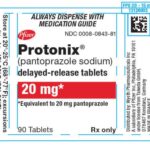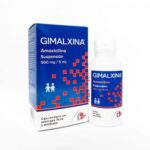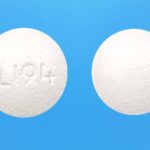Pantoprazole: Uses, Dosage Side Effects, Interactions

Pantoprazole, sold under the brand name Protonix among others, is a medication used to treat damage from gastroesophageal reflux disease (GERD), a condition in which backward flow of acid from the stomach causes heartburn and possible injury of the esophagus (the tube between the throat and stomach) in adults and children 5 years of age and older.
Pantoprazole is used to allow the esophagus to heal and prevent further damage to the esophagus in adults with GERD. It is also used to treat conditions where the stomach produces too much acid, such as Zollinger-Ellison syndrome in adults. Pantoprazole is in a class of medications called proton-pump inhibitors. It works by decreasing the amount of acid made in the stomach.
How should Pantoprazole be used?
Pantoprazole comes as a delayed-release (releases the medication in the intestine to prevent break-down of the medication by stomach acids) tablet and as delayed-release granules to take by mouth. The packets of delayed-release granules must be mixed with applesauce or apple juice and taken by mouth or given through a feeding tube. For the treatment and maintenance of GERD, pantoprazole is usually taken once a day. For the treatment of conditions where the stomach produces too much acid, pantoprazole is usually taken twice a day. The delayed-release tablets are usually taken with or without food, and the granules are usually taken 30 minutes before a meal. Take pantoprazole at around the same time(s) every day. Follow the directions on your prescription label carefully, and ask your doctor or pharmacist to explain any part you do not understand. Take pantoprazole exactly as directed. Do not take more or less of it or take it more often or for a longer period of time than prescribed by your doctor.
Swallow the tablets whole; do not split, chew, or crush them. If your doctor has prescribed the 40 mg tablet and it is too big for you to swallow, ask your doctor to prescribe two of the 20 mg tablets instead.
To take the granules, open the packet and either sprinkle the granules onto one teaspoonful of applesauce or into a cup containing one teaspoonful of apple juice. Do not mix the granules with water, other liquids, or other foods. Use all of the granules in the packet; do not divide the granules into smaller doses. If you sprinkle the granules into apple juice, stir the mixture for 5 seconds. Swallow the mixture of applesauce or apple juice and medication right away (within 10 minutes) without chewing or crushing the granules. If you sprinkled the granules on applesauce, take several sips of water to wash the granules down to your stomach. If you sprinkled the granules into apple juice, rinse the cup once or twice with apple juice and drink the apple juice right away to be sure you swallow any leftover granules.
Pantoprazole granules mixed with apple juice may be given through a feeding tube. If you have a feeding tube, ask your doctor how you should take pantoprazole.
Continue to take pantoprazole even if you feel well. Do not stop taking pantoprazole without talking to your doctor. If your condition does not improve or gets worse, call your doctor.
In case of emergency/overdose
In case of overdose, call the poison control helpline at 1-800-222-1222. Information is also available online at https://www.poisonhelp.org/help. If the victim has collapsed, had a seizure, has trouble breathing, or can’t be awakened, immediately call emergency services at 911.
What are side effects of pantoprazole?
Common side effects of pantoprazole include:
• Headache
• Abdominal pain v
• Facial puffiness
• Generalized swelling (edema)
• Chest pain
• Diarrhea
• Constipation
• Itching
• Rash
• Gas
• High blood sugar (hyperglycemia)
• Nausea
• Vomiting
• Photosensitivity
Other side effects of pantoprazole include:
• Skin swelling
• Atrophic gastritis
• Anterior ischemic optic neuropathy
• Hepatocellular damage leading to hepatic failure
• Interstitial nephritis
• Pancreatitis
• Low white blood cell, red blood cell, and platelet count
• Muscle wasting (rhabdomyolysis)
• Risk of a severe allergic reaction (anaphylaxis)
• Stevens-Johnson syndrome
• Fatal toxic epidermal necrolysis
• Erythema multiforme
Postmarketing side effects of pantoprazole reported include:
• Weakness
• Fatigue
• Feeling unwell (malaise)
• Hepatocellular damage leading to jaundice and hepatic failure
• Agranulocytosis, pancytopenia
• Taste disorders (loss of taste, changes in taste)
• Weight changes
• Low blood sodium (hyponatremia)
• Low blood magnesium
• Bone fracture
• Hallucinations
• Confusion
• Insomnia
• Drowsiness
• Interstitial nephritis
• Severe dermatologic reactions (some fatal), including erythema multiforme, Stevens-Johnson syndrome, and toxic epidermal necrolysis (some fatal), as well as angioedema (Quincke edema)
• Cutaneous and systemic lupus erythematosus
• Cyanocobalamin (Vitamin B-12) deficiency
• Clostridium difficile-associated diarrhea
This document does not contain all possible side effects and others may occur. Check with your physician for additional information about side effects.
Ask your pharmacist or doctor for a copy of the manufacturer’s information for the patient.
Other uses for this medicine
This medication may be prescribed for other uses; ask your doctor or pharmacist for more information.
What special precautions should I follow?
Before taking pantoprazole,
- tell your doctor and pharmacist if you are allergic to pantoprazole, dexlansoprazole (Dexilant), esomeprazole (Nexium, in Vimovo), lansoprazole (Prevacid, in Prevpac), omeprazole (Prilosec, in Zegerid), rabeprazole (AcipHex), any other medications, or any of the ingredients in pantoprazole tablets or granules. Ask your pharmacist for a list of the ingredients.
- tell your doctor if you are taking rilpivirine (Edurant, in Complera, Odefsey). Your doctor will probably tell you not to take pantoprazole if you are taking this medication.
- tell your doctor and pharmacist what prescription and nonprescription medications, vitamins, nutritional supplements, and herbal products you are taking or plan to take. Be sure to mention any of the following: anticoagulants (blood thinners) such as warfarin (Coumadin, Jantoven), atazanavir (Reyataz), dasatinib (Sprycel), digoxin (Lanoxicaps, Lanoxin), diuretics (‘water pills’), erlotinib (Tarceva), iron supplements, itraconazole (Onmel, Sporonox), ketoconazole (Nizoral), methotrexate (Trexall, Xatmep), mycophenolate mofetil (Cellcept), nelfinavir (Viracept), nilotinib (Tasigna), and saquinavir (Invirase). Your doctor may need to change the doses of your medications or monitor you carefully for side effects.
- tell your doctor if you have or have ever had a low level of magnesium in your blood, low levels of vitamin B-12 in your body, osteoporosis (a condition in which the bones become thin and weak and break easily), or an autoimmune disease (condition in which the body attacks its own organs causing swelling and loss of function) such as systemic lupus erythematosus.
- tell your doctor if you are pregnant, plan to become pregnant, or are breastfeeding. If you become pregnant while taking pantoprazole, call your doctor.
- talk to your doctor about the risks and benefits of taking pantoprazole if you are 70 years of age or older. Do not take this medication for a longer period of time than recommended by your doctor.
What special dietary instructions should I follow?
Unless your doctor tells you otherwise, continue your normal diet.
What should I do if I forget a dose?
Take the missed dose as soon as you remember it. However, if it is almost time for your next dose, skip the missed dose and continue your regular dosing schedule. Do not take a double dose to make up for a missed dose.
What other information should I know?
Keep all appointments with your doctor and the laboratory. Your doctor may order certain laboratory tests before and during your treatment, especially if you have severe diarrhea.
Before having any laboratory test, tell your doctor and the laboratory personnel that you are taking pantoprazole.
Do not let anyone else take your medication. Ask your pharmacist any questions you have about refilling your prescription.
It is important for you to keep a written list of all of the prescription and nonprescription (over-the-counter) medicines you are taking, as well as any products such as vitamins, minerals, or other dietary supplements. You should bring this list with you each time you visit a doctor or if you are admitted to a hospital. It is also important information to carry with you in case of emergencies.





